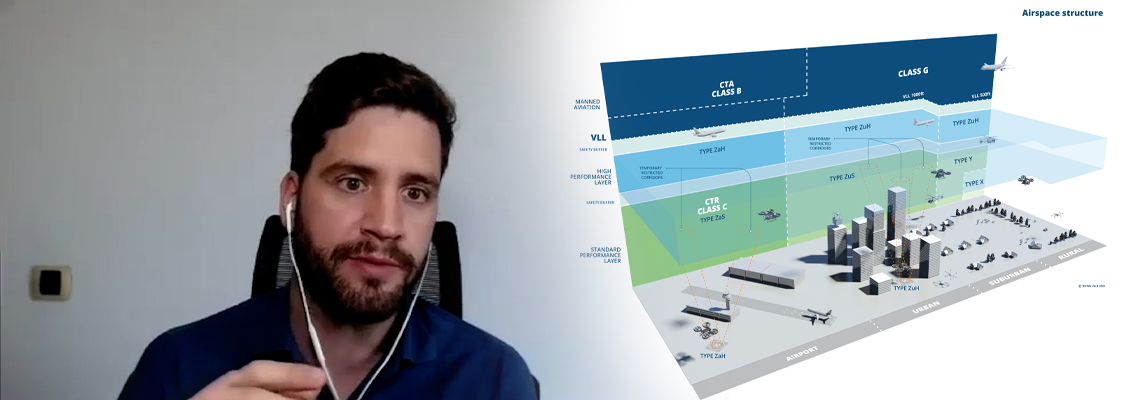AMU-LED nursery for the future of air mobility
More than 17 partners and 30 advisory board members are working together in the ambitious AMU-LED project. One of the participants is Boeing. Senior System Engineer at Boeing Research & Technology, Alejandro Fransoy, talks about the unique form of collaboration and the highly ambitious demonstrations that will take place next year in three different countries. AMU-LED appears to be the nursery for the future of aviation.
Alejandro Fransoy is proud to be one of the members of the European AMU-LED (Air Mobility Urban-Large Experimental Demonstrations) project with more than 17 partners and 30 advisory board members to specify various use cases applicable to logistics and urban transport of passengers, to define their concept of operations and the way to integrate those within other manned and unmanned operations, to demonstrate safety of UAM flights and finally, to assess security, sustainability and public acceptance. “We trust that what we do in AMU-LED will leave a real mark for the future of UAM. And that is really exciting. I’m proud to be part of it since the beginning.”
Ambitious
AMU-LED will test real UAM operations in a U-space eco-system for coordinated flights of several types of UAVs in different scenarios, use cases and applications (e.g. air taxis, emergency services, delivery of goods, surveys, etc.) for surveillance, logistics and mobility using air vehicles. At the end of the project, it will be demonstrated that any city or sub-urban region (e.g. sparsely populated areas) may have the capability to offer UAM services and infrastructures taking into account its specificities, but in a standardized and safe form. Finally, the project will contribute significantly to define the needs and features of the UAM vehicle on-board equipment. A set of various experimentations will be performed in three countries in Europe (the UK, Spain and the Netherlands), towards the test of the aerial platform itself but also the U-space relevant services to be deployed. The lessons learned during the demonstration flights will be shared with European aviation organizations like EASA and EUROCONTROL as well as standardisation bodies so they can be at the basis of new and improved rules and regulations and future standards.
Collaboration
Fransoy describes the role of Boeing in the project. “With the contribution of many other partners, we started leading the definition of the concept of operations for Urban Air Mobility. We contributed afterwards to the identification of a set of representative UAM use cases, scenarios and situations to best infer the roles and responsibilities of the involved UAM actors and services, in the form of functional requirements. During the demonstrations, Boeing will lead the data management process, so that it is gathered and made available for future analysis. Finally Boeing will contribute to validating some of latest standards and regulations with a view to providing feedback to standards bodies and regulators.”
According to Fransoy, the form in which so many different parties work together towards a common goal is quite unique. “Of course companies in the aviation industry have worked together in the past, but I think the scale at which we do that in the UAM industry is new. You can see it in the way we share information and data. Everyone in the project is prepared to do that. Precisely because we have that common goal in mind.”
In the eyes of the Senior System Engineer, UAM has ensured that companies that in the past were mainly each other's competitors now work together. Because in addition to Boeing, Airbus is also a partner in the project. “We help each other to shape the future of air mobility. And we both know we can't really do that without each other. It is still a blank sheet that we are writing together. That is nice to see.”
According to Fransoy, the collaboration is fundamental. Especially because the participants - in addition to the aviation companies also governments, regulatory institutions, research institutes, operators, municipalities and cities - learn so much from each other, and that extends to collaboration with other similar projects. “UAM is a really disruptive innovation and the challenge is not only to demonstrate that the technology is ready but also to explore and compare different implementation alternatives.”
Challenging
AMU-LED tries to demonstrate the capabilities of U-space for UAM. According to Fransoy many different technologies will be tested in the coming year. “Think about small multicopters and fixed wing aircraft, but also about large EVTOL’s. We’re planning for more than 100 hours of flights demonstrating passenger and cargo transport, emergency services, infrastructure inspection and police surveillance missions with various aerial platforms. This will be combined in a series of scenarios that will be split across the different demonstration sites. During summer 2022 we will be having three big demonstration campaigns: in the UK in June, at three sites in the Netherlands in August and finally in Spain in September. During those demos we will be testing two different traffic management architectures: a centralized one and a decentralised one. And we will be testing a whole range of U-space services, like remote ID, flight authorisation, traffic information, conformance monitoring, dynamic airspace reconfiguration and procedural and collaborative interface with ATC amongst others. Technology wise we will also be testing 4G, 5G and satellite connectivity. You can see those are very challenging demos that we are preparing for next year.”
Disclaimer:“This project has received funding from the SESAR Joint Undertaking under the European Union’s Horizon 2020 research and innovation programme under grant agreement No 101017702.”
Share your story with us
Do you have knowledge on current air solutions, potential innovations and vital regulations you would like to share with the UAS community? The Amsterdam Drone Week website and social media channels are a great platform to showcase your stories!
Please contact our Brand Marketing Manager Hilke de Vries.
